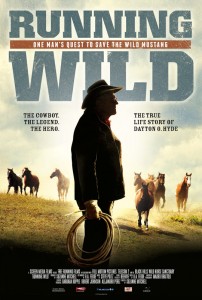
Release Date: October 4, 2013 (Limited)
Director: Suzanne Mitchell
MPAA Rating: NR
Film Pulse Score: 2.5/10
Suzanne Mitchell’s Running Wild is subtitled The Life of Dayton O. Hyde and indeed the film is based on this man with, what shall we call it, “gumption.” Past 80 years of age today, he left his home in Oregon approximately 20 years ago and created the Black Hills Wild Horse Sanctuary in South Dakota. The film is a slow-moving tale of his various personal triumphs during the last eight decades. It does not tell his life’s journey well, however, and I was ultimately disappointed with the film’s quality and quantity of storytelling.
Hyde has always loved horses and ranching, more broadly, he has always loved animals and nature from his birth in Michigan to his days in Oregon and ultimately to his time at the sanctuary in South Dakota. Some 20 years ago, he was traveling and came upon some horses in bad shape. He decided to intervene and created a sanctuary for wild horses; whether there are some domesticated horses on site as well remains unclear. Hyde’s love for horses became his life’s calling and he uprooted himself from his home to relocate himself to where he set up the horses. The film includes some of his children who were grown when their father made the decision to leave (it is also unclear whether he divorced his wife at the same time he left, for he has a “lady friend” at the sanctuary and his former(?) wife briefly appears in the documentary). Dayton, Jr., spends a few times at the sanctuary each year and the film focuses, to some degree, on their obviously strong relationship.
The film dips into his past, but never for very long and never really long enough to help an audience understand Hyde’s development. There are some interesting tidbits about his father – who died at an early age from multiple sclerosis – as well as about his schooling and ranching and rodeo days, but they are mere tidbits in the grand scheme of things. The film would have done well to extend the film’s running time and delve deeper into what appears to have been a pretty colorful past.
Other than focusing on the horses’ existence at the sanctuary, the film highlights Hyde’s conservationist activities in the broader environmental and ecological landscape. It spends some time on his fight against a Canadian mining company that wants to dig uranium wells in the area, along the all-important Cheyenne River. Hyde is fighting the company which, as of the documentary’s filming a couple of years ago, had not gotten the necessary permits, perhaps because of at least some of Hyde’s efforts. As many people have echoed, Hyde was and is concerned about the ecological effects of drilling for uranium, particularly so close to a major waterway – what it would do to the larger landscape as well as to the wild horses’ environment in particular.
Hyde is the author of some 20 books, passage readings from some of which are included in the documentary. From these passages as well as the interviews included, the film shows Hyde to be a deep-thinking man and a man of conviction. But the film gives only a superficial examination of Hyde’s qualities. The production values are not extraordinary, so that even the beautiful scenery and horses are not shown in their prime. This is just as disappointing as the film’s narrative itself. Unless you have a preexisting, particular interest in Dayton O. Hyde, I can tell you that you will not miss anything important if you miss this film. And this is a shame given the importance of the natural wildlife and their surroundings which are touched on by the film’s person-centered subject matter.






